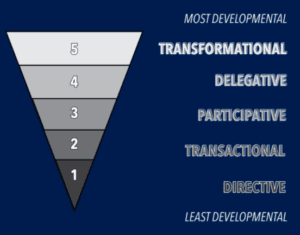
When we don’t trust someone, we often try to control them. Of course, we know that the three things we can control are our actions, our perspective, and who we trust. We can choose to trust someone, but we cannot control how they act and respond.
When we trust someone, we move them up the Freedom V and use more developmental leadership styles like Participative and Transformational. Versus we might use Directive or Transactional Leadership with someone who is further down the Freedom V who we don’t trust as much.
Delegative Leadership

We’re going to focus on Delegative Leadership to see why this leadership style is essential for understanding the relationship between trust and control. This is the second-most developmental leadership style, second only to Transformational. This style is to be used with someone that you trust and who has proven themselves to be able to handle more responsibility.
Delegative Leadership is not simply telling someone what to do. That would be Directive Leadership, which is for people low on the Freedom V. With Directive Leadership, you assign the steps along the Path that you want someone to walk. But with Delegative Leadership, you assign the There and give them the task of finding the Path. You both will be aligned with the same end goal, but the way that the goal is reached will be up to the person with delegated authority.
Where control comes into play is that you can delegate authority, but you cannot delegate responsibility. In other words, you don’t assign the There and then disappear until it’s reached. Once the task has been delegated, the leader is still responsible for checking in on the project throughout the process.
But how often should a leader check in? And how do you strike the balance between micromanaging and being distant? How much should you try and control, and how much should you leave up to them?
Expectations
A good place to start is by setting expectations at the beginning. This ensures that both parties know the plan and can agree on one that works for both of them.
Without established expectations from the beginning of the project, it would be all too easy for the leader to be checking in with what she feels is too many times, but the person with the delegated authority is confused as to why she doesn’t check in more. Creating a plan for the frequency of check ins will eliminate the uncertainty of questioning every time if you need to check in.
And remember, learning and adjusting is part of life on the Path. If you find that the agreed upon number isn’t working at any point in the process, you have the freedom to change it. Just make sure that, once again, both people are in agreement about the change and know what to expect moving forward.
Boundaries
You can set boundaries and expectations as to the frequency of check-ins, and also what needs to be approved or what the delegated person has the authority to move forward with.
The impulse behind this has to do with clarifying language. What I mean when I say “you are in charge of this project” will inevitably be different from what the other person understands it to mean. Does being in charge mean that they get to call every single shot? Or is there anything that needs to be run by the leader before moving ahead?
In order to be effective in the role they have been given, a person with delegated authority must know what they have the freedom to do independently. This is an essential step of establishing someone’s Freedom V.
If you trust someone, you will relinquish control and give them more authority, moving them up the Freedom V. But as you do so and use Delegative Leadership, you must clearly define expectations and boundaries to set them up for success.
Gracie McBride is the Content and Systems Management Coordinator for The Crossroad.




